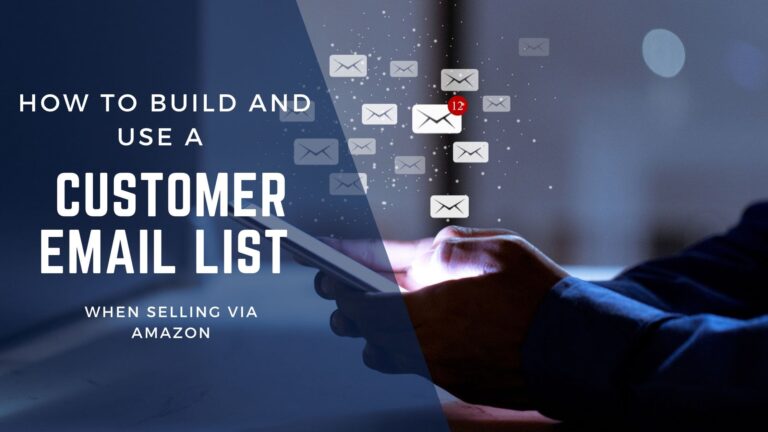Introduction: Why Amazon Sellers Need an Email List
Selling on Amazon is exciting, but it also comes with a hidden risk most sellers don’t think about until it’s too late. You don’t actually own the relationship with your customers. Amazon owns the traffic, the buyers, and even the email addresses. For many sellers, this dependency becomes a ticking time bomb. Imagine one sudden policy change or suspension and your entire revenue stream disappears overnight.
That’s where email lists come in. Think of Amazon as rented land—you’re building your business on their property, with rules that can change anytime. Your email list, on the other hand, is owned land. It’s where you have full control to build connections, drive repeat purchases, and nurture your brand’s long-term growth. Without one, you’re leaving money, stability, and customer loyalty on the table.
Table of Contents
- What Amazon Allows (and What It Doesn’t)
- Why Building an Email List Matters
- TOS-Compliant Methods to Build Your Email List
- Creative Email Collection Tactics for Amazon Sellers
- Amazon Seller Email List Building Strategy
- Email Marketing Tactics for Sellers
- Case Study Examples
- Pitfalls to Avoid
- Measuring Success and Scaling
- FAQs
- Conclusion: Building Long-Term Relationships
What Amazon Allows (and What It Doesn’t)
One of the first questions new sellers ask is: Is it allowed by Amazon to ask customers for their email? The short answer is yes, but only if you do it the right way. Amazon is extremely protective of customer data. They hide buyer email addresses and limit your ability to contact customers outside of order-related messages. That means scraping emails from Amazon or sending promotional messages through Seller Central is strictly against their Terms of Service.
However, Amazon does allow indirect but compliant approaches. For example, you can include package inserts, customer service follow-ups, or QR codes that lead to an external landing page. The key is positioning—your message must focus on adding value, not soliciting reviews or violating trust. Following TOS compliant Amazon email collection methods ensures that your business stays safe while still growing its reach.
Why Building an Email List Matters
Many sellers underestimate how powerful email marketing can be because they rely on Amazon’s organic traffic. But let’s be clear: Amazon is a discovery engine, not a loyalty engine. Without an email list, you’re always chasing new customers instead of nurturing the ones you already have. If you’re curious how Amazon’s ranking system drives discovery, study how A9 works; then build your email list to handle loyalty and retention.
An email list gives you the ability to build brand loyalty through personalized storytelling. Imagine a customer who buys a posture corrector from you on Amazon. With an email list, you can follow up with advice on posture habits, tips for desk workers, and even introduce related products like knee braces or lumbar support belts. This kind of personalized engagement not only drives repeat sales but also builds trust.
It also shields you from platform risk. If Amazon suddenly suspends your account or changes its algorithm, you still have direct access to your customers. How can Amazon sellers legally collect customer emails? By using the compliant methods we’ll cover next—methods that protect both your business and your reputation.
TOS-Compliant Methods to Build Your Email List
So, what are the actual compliant ways to collect emails? The most popular is through package inserts. But it’s not as simple as sliding a flyer into your box and saying “Sign up here for a discount.” That can easily get flagged. Instead, focus on value. A compliant email list Amazon package insert might invite customers to register their warranty, download a free usage guide, or access exclusive tutorials.
QR codes make this process even smoother. Customers can scan and be taken directly to a landing page where they can opt in. And yes, can QR codes be used to direct Amazon customers to an email signup? Absolutely—so long as the page provides genuine value. Pair the QR code with a short, non-intrusive message like: “Scan to unlock bonus recipes” or “Register your free 1-year warranty here.”
Finally, don’t overlook customer service follow-ups. You can direct buyers to a help center or support portal where, again, an email opt-in can happen naturally. These strategies are all TOS-compliant because they prioritize customer experience first.
Creative Email Collection Tactics for Amazon Sellers
While compliance is the foundation, creativity is what sets your brand apart. One effective approach is using giveaways or contests. Instead of saying, “Sign up for 10% off,” you could run a campaign where customers who register with their email have a chance to win a free product bundle. It feels fun, adds value, and encourages organic sharing.
Educational content is another powerful tactic. For example, if you sell kitchen gadgets, offer a free recipe eBook in exchange for an email. If you sell fitness products, provide a 7-day workout plan. This approach builds authority and positions you as more than just a seller—you become a trusted guide.
These kinds of creative approaches answer the common PAA question: What methods are TOS-compliant for email list building on Amazon? They are compliant because they don’t pressure customers, they add genuine value, and they respect Amazon’s rules.
Amazon Seller Email List Building Strategy
If you’re starting from zero, building an email list can feel overwhelming. That’s why it’s important to follow a step-by-step roadmap. A good Amazon seller email list building strategy starts small. Begin with a simple landing page and one value offer, like a PDF guide or warranty registration. Promote it through package inserts and customer service follow-ups.
Next, connect your landing page to an email marketing tool such as MailMint. These platforms make it easy to automate emails, segment your audience, and track performance. Over time, nurture your list with helpful content before moving into promotions. A simple welcome sequence can work wonders, followed by occasional brand storytelling and product education.
This roadmap ensures that you don’t just collect emails, but also turn them into long-term relationships that fuel your business beyond Amazon.
Email Marketing Tactics for Sellers
Once your list is growing, it’s time to put it to work. A good first step is creating a welcome series that tells your brand story. Introduce who you are, why your brand exists, and how your product can improve your customer’s life. From there, you can run cross-selling and upselling campaigns. If someone bought a knee brace, send them an email about your new ankle compression sleeve. If a customer picked up a kitchen chopper, introduce them to your premium knife set.
Finally, email allows you to run seasonal promotions and product launches. Black Friday, Mother’s Day, or even niche events like International Yoga Day become opportunities to re-engage your audience. If you plan promos alongside Amazon-native levers, a good place to start is a concise Lightning Deals strategy for peak moments.
Case Study Examples
Let’s bring this to life with real examples. One fitness accessories brand included a simple insert card that invited customers to register their warranty online. The opt-in form also offered a free 7-day workout challenge. Within 6 months, the brand built a list of over 10,000 engaged subscribers, many of whom went on to buy their new resistance band set.
Another seller in the home goods niche used educational content. They created a “10 Easy Recipes” PDF for their air fryer customers. Each download required an email signup. That campaign not only added thousands of subscribers but also positioned the brand as an authority in cooking, boosting repeat sales.
Finally, a skincare seller used QR code campaigns. Their insert read: “Scan to unlock your personalized skincare routine.” Customers loved the tailored advice, and the brand’s list grew rapidly. These case studies prove that compliant, value-driven strategies can produce amazing results.
Pitfalls to Avoid
Of course, not all email collection strategies are created equal. Some can actually harm your brand. One of the biggest mistakes is offering reviews in exchange for email signups. This is a direct violation of Amazon policy and can lead to suspension.
Another pitfall is using discount traps that feel manipulative. If your entire pitch is “Give me your email for 50% off,” you’re not building long-term trust—you’re just training customers to wait for discounts. For broader operational missteps you’ll want to avoid, review these common Amazon seller mistakes.
Lastly, don’t fall into the trap of over-emailing new subscribers. Sending daily messages or irrelevant content leads to unsubscribes and damages your credibility. Remember, email marketing is a marathon, not a sprint.
Measuring Success and Scaling
Once you have a working system, it’s time to measure results. Start by tracking opt-ins and conversion rates. How many people scan your QR code? How many actually sign up? From there, monitor key email engagement metrics like open rates, click-through rates, and unsubscribe rates. These KPIs tell you whether your content is resonating. For your operational dashboard, build from the key Seller Central metrics that matter to growth.
As your list grows, consider scaling beyond Amazon. Partner with influencers, run paid ads that drive traffic to your landing page, or launch your own branded website. When you want to send cold traffic to your ASINs (e.g., for launches or seasonal pushes), learn practical ways to drive traffic to your listings. Expanding list growth outside Amazon ensures your brand becomes independent, stable, and ready for long-term success.
FAQs
How can Amazon sellers legally collect customer emails?
By using compliant methods like package inserts, QR codes, and customer service follow-ups that focus on adding value rather than soliciting reviews.
Is it allowed by Amazon to ask customers for their email?
Yes, but only indirectly. Amazon hides customer email addresses, so sellers must invite customers to voluntarily opt in through compliant funnels.
What methods are TOS-compliant for email list building on Amazon?
Educational content, warranty registrations, QR codes, and giveaways are all compliant methods, as long as they prioritize customer value.
How effective are package inserts for building email lists?
Extremely effective when used correctly. Inserts that provide value—like warranty registration or exclusive guides—see much higher opt-in rates.
Can QR codes be used to direct Amazon customers to an email signup?
Yes. QR codes are a simple and compliant way to connect customers to opt-in pages, provided the landing page delivers genuine value.
Conclusion: Building Long-Term Relationships
At the end of the day, building an email list is about much more than collecting addresses. It’s about creating meaningful connections with your customers and protecting your business from platform dependency. By following compliant methods and focusing on value, you can turn one-time Amazon buyers into lifelong brand advocates.
Remember: Amazon is rented land. Your email list is owned land. Invest in it, nurture it, and it will pay you back with stability, loyalty, and growth.
Ready to take the next step? join our three day live workshop to learn proven strategies for building your list. The earlier you start, the faster your brand grows beyond Amazon.










One Response
Good 👍